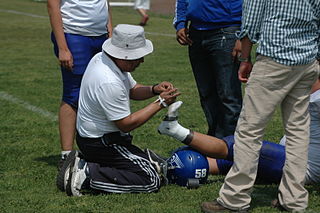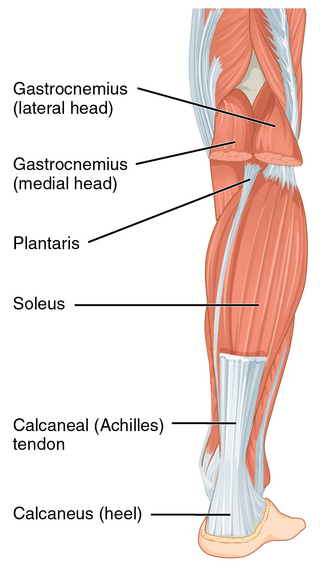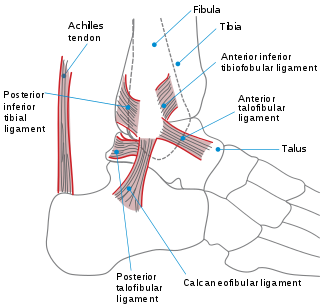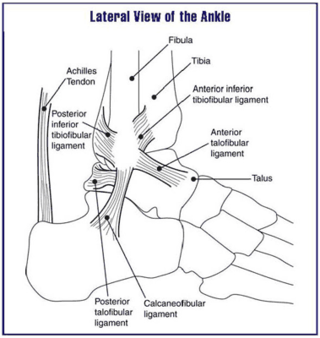
Sports injuries are injuries that occur during sport, athletic activities, or exercising. In the United States, there are approximately 30 million teenagers and children who participate in some form of organized sport. Of those, about three million athletes age 14 years and under experience a sports injury annually. According to a study performed at Stanford University, 21 percent of the injuries observed in elite college athletes caused the athlete to miss at least one day of sport, and approximately 77 percent of these injuries involved the knee, lower leg, ankle, or foot. In addition to those sport injuries, the leading cause of death related to sports injuries is traumatic head or neck occurrences.

Tendinopathy is a type of tendon disorder that results in pain, swelling, and impaired function. The pain is typically worse with movement. It most commonly occurs around the shoulder, elbow, wrist, hip, knee, or ankle.

The Achilles tendon or heel cord, also known as the calcaneal tendon, is a tendon at the back of the lower leg, and is the thickest in the human body. It serves to attach the plantaris, gastrocnemius (calf) and soleus muscles to the calcaneus (heel) bone. These muscles, acting via the tendon, cause plantar flexion of the foot at the ankle joint, and flexion at the knee.

Achilles tendinitis, also known as achilles tendinopathy, occurs when the Achilles tendon, found at the back of the ankle, becomes sore. Achilles tendinopathy is accompanied by alterations in the tendon's structure and mechanical properties. The most common symptoms are pain and swelling around the affected tendon. The pain is typically worse at the start of exercise and decreases thereafter. Stiffness of the ankle may also be present. Onset is generally gradual.

Plyometrics, also known as jump training or plyos, are exercises in which muscles exert maximum force in short intervals of time, with the goal of increasing power (speed-strength). This training focuses on learning to move from a muscle extension to a contraction in a rapid or "explosive" manner, such as in specialized repeated jumping. Plyometrics are primarily used by athletes, especially martial artists, sprinters and high jumpers, to improve performance, and are used in the fitness field to a much lesser degree.

Sports equipment, sporting equipment, also called sporting goods, are the tools, materials, apparel, and gear used to compete in a sport and varies depending on the sport. The equipment ranges from balls, nets, and protective gear like helmets. Sporting equipment can be used as protective gear or a tool used to help the athletes play the sport. Over time, sporting equipment has evolved because sports have started to require more protective gear to prevent injuries. Sporting equipment may be found in any department store or specific sporting equipment shops.

Achilles tendon rupture is when the Achilles tendon, at the back of the ankle, breaks. Symptoms include the sudden onset of sharp pain in the heel. A snapping sound may be heard as the tendon breaks and walking becomes difficult.

Patellar tendinitis, also known as jumper's knee, is an overuse injury of the tendon that straightens the knee. Symptoms include pain in the front of the knee. Typically the pain and tenderness is at the lower part of the kneecap, though the upper part may also be affected. Generally there is no pain when the person is at rest. Complications may include patellar tendon rupture.
A negative repetition is the repetition of a technique in weight lifting in which the lifter performs the eccentric phase of a lift. Instead of pressing the weight up slowly, in proper form, a spotter generally aids in the concentric, or lifting, portion of the repetition while the lifter slowly performs the eccentric phase for 3–6 seconds.

A sprained ankle is an injury where sprain occurs on one or more ligaments of the ankle. It is the most commonly occurring injury in sports, mainly in ball sports such as basketball, volleyball, football, and tennis.

Patellar tendon rupture is a tear of the tendon that connects the knee cap (patella) to the tibia. Often there is sudden onset of pain and walking is difficult. In a complete rupture, the ability to extend that knee is decreased. A pop may be felt when it occurs.

An anterior cruciate ligament injury occurs when the anterior cruciate ligament (ACL) is either stretched, partially torn, or completely torn. The most common injury is a complete tear. Symptoms include pain, an audible cracking sound during injury, instability of the knee, and joint swelling. Swelling generally appears within a couple of hours. In approximately 50% of cases, other structures of the knee such as surrounding ligaments, cartilage, or meniscus are damaged.

In volleyball, spiking is the offensive play where a player swings the ball with their palm sharply downwards over the net and into the opposing court, making it difficult for the opposing team to recover the ball. The mechanism of spiking is unique to volleyball, but its counterparts in other sports include slam dunking in basketball, smashing in tennis, or shooting in association football.

Netball is a sport that has one of the largest female participation rates within the Commonwealth, most popular in the United Kingdom, Australia and New Zealand, with more than 20 million athletes participating in the sport. Netball is a ball sport played by two teams of seven players in which goals are scored by shooting the ball through a netted ring. Netball relies heavily on muscular endurance and bursts of rapid acceleration to “break free” from an opponent as well as, sudden and rapid change of directions in combination with jumping to receive a pass, intercept a ball or rebound. The sudden stop-start motion of the game is what often leads to serious injuries in participants. Higher grade players, in both senior and junior competitions, are more susceptible to injuries than lower grade players, due to the high intensity and rapid pace of the game. An injury is most commonly defined as one that has occurred while participating in sport and which led to one of the following consequences: a reduction in the amount or level of sports activity; need for medical advice or treatment; and/or adverse economic or social effects for the athlete.
The most common injuries in the sport of cricket occur in the lower back, thighs, shoulders, and hands. They can be classified as direct injuries or indirect injuries. Direct injuries are due to impact with the cricket ball, bat, or ground. Indirect injuries occur mostly due to repetitive movement causing overuse of muscles. Fast bowlers have the highest injury prevalence rate followed by batsmen.
Muscle strain is one of the most common injuries in tennis. When an isolated large-energy appears during the muscle contraction and at the same time, bodyweight applies huge amounts of pressure to the lengthened muscle, which can result in the occurrence of muscle strain. Inflammation and bleeding are triggered when muscle strain occur which resulted in redness, pain and swelling. Overuse is also common in tennis players from all levels. Muscle, cartilage, nerves, bursae, ligaments and tendons may be damaged from overuse. The repetitive use of a particular muscle without time for repair and recover in the most common case among the injury.
In Australian rules football, injuries are common and consistent due to the nature of the game as a contact sport. The Anterior cruciate ligament (ACL) knee injury is one of the three major and common injuries which occur in the sport. The ACL injury can have long-term effects on the player, not only in physical activity but also in their own daily lives in the future. Studies have attempted to understand and find prevention techniques for ACL injuries, but the scarcity of data precludes any conclusions for male athletes. Female athletes, however, have shown reductions in the rate of ACL injuries through the use of strength training and technique improvement. Once a player has injured their ACL, there is a very high possibility that the injury can occur again to the same knee. There is also the chance of the opposite knee being injured due to the player protecting the reconstructed knee.
Running injuries affect about half of runners annually. The frequencies of various RRI depend on the type of running, such as speed and mileage. Some injuries are acute, caused by sudden overstress, such as side stitch, strains, and sprains. Many of the common injuries that affect runners are chronic, developing over longer periods as the result of overuse. Common overuse injuries include shin splints, stress fractures, Achilles tendinitis, Iliotibial band syndrome, Patellofemoral pain, and plantar fasciitis.

Ankle problems occur frequently, having symptoms of pain or discomfort in the ankles.
Lace bite is an irritation of the tibialis anterior and toe extensor tendons. The medical term for the condition is "tibialis anterior tendinopathy." This irritation, felt on the front of the foot or ankle, is often experienced by ice hockey players and figure skaters. It is caused by friction between the tendon and tongue of the ice skate.

















